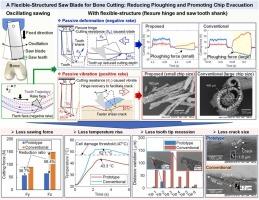A novel flexible-structured saw blade for bone cutting: reducing ploughing and promoting chip evacuation
IF 7.5
2区 材料科学
Q1 ENGINEERING, INDUSTRIAL
Journal of Materials Processing Technology
Pub Date : 2025-08-05
DOI:10.1016/j.jmatprotec.2025.119000
引用次数: 0
Abstract
Oscillating bone sawing is widely employed in orthopedic surgery due to its ability to achieve precise bone resection with minimal damage to surrounding soft tissues. However, conventional saw blades with large negative rake angles often induce excessive ploughing forces, elevated temperatures, poor chip evacuation, accelerated tooth tip wear, and crack formation in bone tissue. While trajectory and vibration-assisted strategies have been explored, their reliance on complex mechanical systems limits clinical adoption. In this study, a novel saw blade with an embedded flexible structure is proposed, which passively adjusts the depth of cut through elastic deformation of the flexible structure. This design offers two key advantages: (1) when cutting with a negative rake face, the flexible tooth adaptively reduces the actual depth of cut, thereby reducing ploughing forces; and (2) when cutting with a positive rake face, periodic elastic deformation induces passive low-frequency vibrations, promoting shear crack formation and transforming continuous, spiral-like chips into fine, needle-like fragments, thereby improving chip evacuation. Multi-tooth sawing experiments confirmed that the proposed blade reduced sawing forces by 56.4 % in the feed direction and 36.7 % in the oscillation direction, suppressed peak cutting temperature to 43.3 °C (below the 47 °C threshold for cell damage), and significantly decreased tooth tip wear and groove wall cracking. These results demonstrate the effectiveness of the proposed structure as a compact, mechanically simple solution that complements motion-based strategies, enhancing cutting performance and adaptability in bone cutting applications.

一种用于骨切割的新型柔性结构锯片:减少犁耕和促进切屑的排出
振荡骨锯在骨科手术中被广泛应用,因为它能够在对周围软组织损伤最小的情况下实现精确的骨切除。然而,具有较大负前角的传统锯片通常会导致犁削力过大、温度升高、屑排出不良、齿尖磨损加速以及骨组织中裂纹的形成。虽然已经探索了轨迹和振动辅助策略,但它们对复杂机械系统的依赖限制了临床应用。本文提出了一种新型嵌入式柔性结构锯片,通过柔性结构的弹性变形被动调节锯切深度。该设计具有两个主要优点:(1)当采用负前刀面切削时,柔性齿自适应减小实际切削深度,从而减小犁耕力;(2)正前刀面切削时,周期性弹性变形诱发被动低频振动,促进剪切裂纹的形成,将连续的螺旋状切屑转变为细小的针状切屑,从而提高切屑排屑率。多齿锯切实验证实,该叶片在进给方向和振荡方向的锯切力分别降低了56.4% %和36.7% %,将切削峰值温度抑制在43.3℃(低于47℃细胞损伤阈值),并显著降低了齿尖磨损和槽壁开裂。这些结果证明了所提出的结构作为一种紧凑,机械简单的解决方案的有效性,补充了基于运动的策略,增强了骨切割应用的切割性能和适应性。
本文章由计算机程序翻译,如有差异,请以英文原文为准。
求助全文
约1分钟内获得全文
求助全文
来源期刊

Journal of Materials Processing Technology
工程技术-材料科学:综合
CiteScore
12.60
自引率
4.80%
发文量
403
审稿时长
29 days
期刊介绍:
The Journal of Materials Processing Technology covers the processing techniques used in manufacturing components from metals and other materials. The journal aims to publish full research papers of original, significant and rigorous work and so to contribute to increased production efficiency and improved component performance.
Areas of interest to the journal include:
• Casting, forming and machining
• Additive processing and joining technologies
• The evolution of material properties under the specific conditions met in manufacturing processes
• Surface engineering when it relates specifically to a manufacturing process
• Design and behavior of equipment and tools.
 求助内容:
求助内容: 应助结果提醒方式:
应助结果提醒方式:


